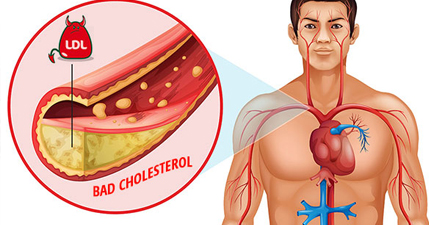Some details about cholesterol - how it affects and prevention/remedies
Posted on: 31/Mar/2018 1:05:34 PM

The very mention of the word ‘cholesterol’ creates a pang of fear in most of us in recent times.
Cholesterol is one of those afflictions to the human body where no outward symptoms are indicated for detecting. Cholesterol affects the middle as well as the old age groups.
All of us must be aware that the fats get deposited on the blood carrying paths and veins from a very young age.
What happens if cholesterol level increases?
There would be no body pain, neck pain, or heart pain or any other complaint when affected by increased cholesterol level. However, gradually, there may be serious complaints such as paralytic attacks, heart attack, kidney diseases, eyesight related problems.
While there are no external symptoms to detect the high cholesterol level, the same can be tested and confirmed through a blood test.
A test, known as ‘lipid profile’ is conducted. Lipid profile or lipid panel is a panel of blood tests that serves as an initial broad medical screening tool for abnormalities in lipids, such as cholesterol and triglycerides.
This test must be taken only in the body condition when no food had been taken in the previous 12 hours. Even drinks must be avoided, Only water can be taken during these 12 hours.
It is advisable to have this test for males above 35 years of age and females above 45 years of age.
However, it is better for all people with prospects of excess fat in their bloodlines to take this blood test.
It is really essential for the following cadres of all age groups to have this blood test as mandatory:
· People with high blood pressure
· Diabetics
· People affected by renal failure
· People affected by heart attacks or paralytic attacks.
· The hereditary or relatives of the above cadre
· People with obesity
· People with habits of smoking/drinking
· The workers who do not have scope for physical exercises in their jobs
· Women after menopause
There are different types of blood cholesterol – Total cholesterol, LDL, HDL, and triglyceride. Out of this the complaint deserving the utmost attention is the cholesterol, known as ‘bad cholesterol’ or LDL – ‘Low-Density Lipoprotein’ and triglyceride cholesterol.
The food habits constitute only 25% of reasons for these complaints whereas there are other factors that constitute 75% of these complaints.
Let us know these ‘other factors’ and their play:
· Hereditary features – 15%
· Obesity – 12%
· Hormones and enzymes – 2%
· Mental tension, tending to be sensitively emotional, the social status – 8%
· Diabetes – 7%
· Lifestyle without much physical exercises – 6%
· Smoking and pollution/environmental hazards – 6%
· The gender, ageing factor, some drugs and similar other factors – 5%
However, the food habit is the highest constitutional factor with 25% in the cause of bad cholesterol. Thus, the wrong food habits are the main reason for bad cholesterol increase. After the food habit, the hereditary feature is the next most important constituent leading to this complaint.
Now, what are the steps to avoid the bad cholesterol?
· Avoid high-cholesterol food items
· Make a serious attempt to reduce the quantity of intake of all high-fat food items
· Take additional quantities whole-grain foods, vegetables, and fruits.
· Just give up the smoking and drinking habits
· Make it a regular habit to take physical exercises it specified periods.
· Take care to maintain the body weight as recommended by the height.
· Take regular medical check-ups and strictly follow the medical advice
· It is of paramount importance to keep the blood pressure and the sugar level under control for the patients with these complaints.
So, if you take care and act accordingly, there is no fear about ‘bad cholesterol’.







